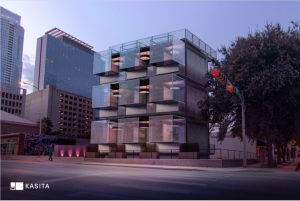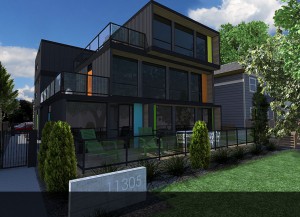By Erica Rascón on May 19, 2016 in News
Economic crises and housing shortages have ins pired many architects and engineers. Their desire to solve modern housing dilemmas has resulted in several affordable, efficient, and accessible units that change the way that we see multifamily housing.
pired many architects and engineers. Their desire to solve modern housing dilemmas has resulted in several affordable, efficient, and accessible units that change the way that we see multifamily housing.
Below are two recent example of space-savvy and cost-effective housing. They could promote big changes in the multifamily marketplace.
Kasita
He started off by living in a dumpster. Apparently, that’s a great place to seek revelation.
Dr. Jeff Wilson, a professor at Huston-Tillotson University in Austin lived in a 33-square-foot dumpster for a year. The experience brought him a sense of balance, flexibility, and simplicity that he feels the need to share with others. Dr. Wilson created Kasita, a tiny house made for urban settings.
Traditional tiny houses are solitary and rustic. They’re often set up in the suburbs or rural areas. Owning one—and having a place to put it—requires connections to friends with available lots or enough cash to own a plot of land. Kasita is not this type of tiny house.
Each 208-square-foot Kasita is meant to be stacked on “racks,” frames that work a bit like the skeleton of an apartment building. Racks provide hookups for city utilities. By stacking Kasitas vertically, owners can make the most of available space in urban settings.
No land ownership is required. Simply a phone call can move owners from a rack in one city to an available rack elsewhere. A big-rig transports the Kasitas to one of 10 racks scheduled to open nationwide.
Kasitas are a far cry from the cramped, one-size-fits-all cubes seen in dystopia movies. Inside, Kasitas allow for customization through a unique, wall-mounted tile system: shelves, cabinetry, and countertops can be configured to owners’ specifications. These features are a nice addition to a fully functional kitchen and 9-foot tall ceilings.
Traditional tiny houses surprise guests with a few cleverly hidden storage spaces. Kasita delights and surprises guests with tech toys. Voice-activated features include lighting, entertainment systems, and furniture. Just let your Kasita know when you’re ready for bedtime and a queen-sized bed will emerge from the walls.
HonoMobo
 For buyers who want stackable living without the portability factor, HonoMobo is a great alternative. These converted shipping containers come in three floor plans ranging from 352 square feet to 640 square feet.
For buyers who want stackable living without the portability factor, HonoMobo is a great alternative. These converted shipping containers come in three floor plans ranging from 352 square feet to 640 square feet.
HonoMobos offer a large degree of flexibility. Owners can determine interior design features as well as structural components. These prefabricated homes come in a spectrum of R values for the insulation of the roof and walls. All models are photovoltaic-compatible and offer air source heat pumps and hot water tanks. Owners that want a bit more green can further customize the efficiency of air and water systems.
Owners can stack HonoMobos to create apartment buildings—imagine creating an apartment complex of all of your best friends—but since sizes vary, creating the structure may feel and look a bit like Tetris.
One of the most convenient features of these Canadian gems is the ability to order them online. Order a pizza as well as a house to eat it in with just a few clicks. (It can take up to ten weeks to get your HonoMobo, so eat your pizza while it’s still warm.)
Moving Forward
Stackable tiny houses combine the best of renting and homeownership: low-maintenance living, a social atmosphere, no rent hikes, complete ownership, and the ability to move without fussing over home sales.
The quantity of prefabricated and tiny homes is still quite limited in comparison to traditional multifamily communities. Yet we can’t underestimate their influence on the industry. Their growing popularity is reason keep these tiny underdogs on the radar.


